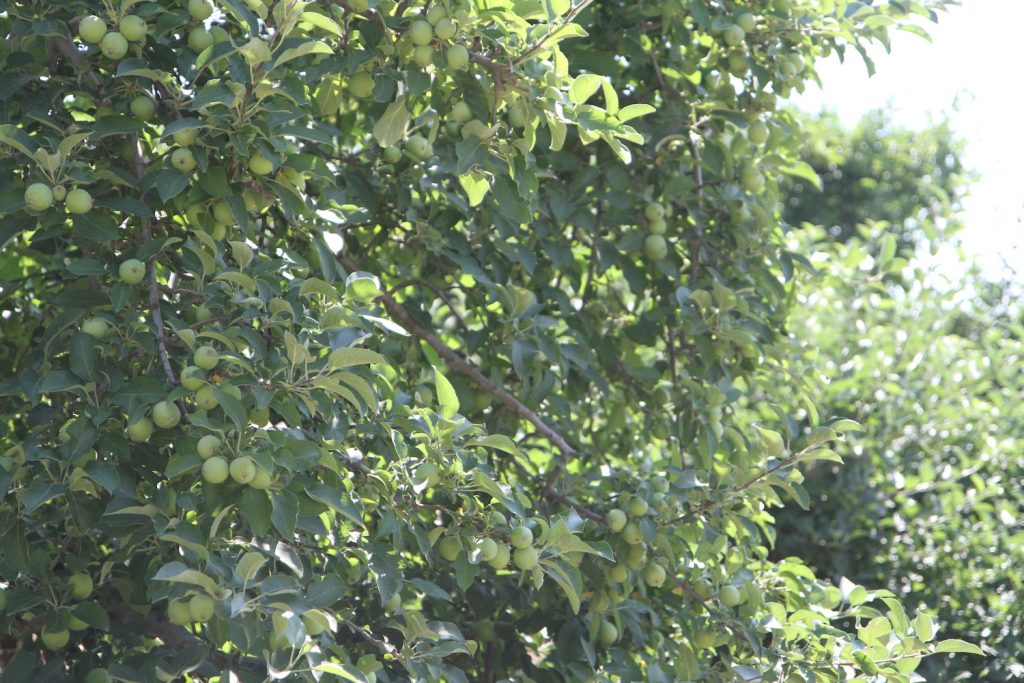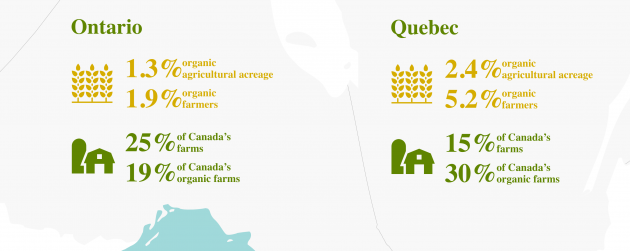
News
Organic production
Farmland growing organic fruits and vegetables increased by 15 per cent since 2016
July 16, 2020 By Stephanie Gordon
 Apple certified organic area represented 4.1 per cent of total apple acreage nationally. Photo courtesy of Alex Barnard.
Apple certified organic area represented 4.1 per cent of total apple acreage nationally. Photo courtesy of Alex Barnard. Organic cultivated area in Canada in 2019 increased by 15.4 per cent from 2016, when the Statistics Canada’s Census of Agriculture counted 14,526 hectares (ha) from farms reporting certified organic products for sale.
In 2019, fruit and vegetable certified organic cultivated area was estimated at 17,171 ha, accounting for 7.4 per cent of the entire fruit and vegetable cultivated area in Canada.
Quebec accounted for over 80 per cent of total certified organic fruit area and almost 75 per cent of certified organic vegetable area nationally in 2019.
This upward trend is on par with organic production outside of Canada. In Europe, 7.5 per cent of total agricultural land was certified organic in 2018 according to Eurostat. In May 2020, the European Commission unveiled its Farm to Fork Strategy which included a commitment to bring 25 per cent of agricultural land in Europe under organic farming by 2030.
In the United States, exported organic products, mainly fruits and vegetables, were worth $548 million in 2016 according to the United States Department of Agriculture (USDA). Of the exported organic products, 70 per cent were exported to Canada and Mexico.
Fruits
Certified organic fruits account for 8.6 per cent of the total fruit farm gate value in Canada for 2019.
According to Statistics Canada, total certified organic fruit cultivated area in Canada was estimated at 12 934 ha in 2019, with Quebec accounting for the largest share (84.6 per cent), followed by British Columbia (10.6 per cent). Wild blueberries (77.8 per cent) and cranberries (16.4 per cent) accounted for almost all of the certified organic cultivated area in Quebec.
Wild blueberries (77.8 per cent) and cranberries (16.4 per cent) accounted for almost all of the certified organic cultivated area in Quebec.
Certified cultivated organic apples totalled 694 ha, mainly concentrated in Quebec (45.5 per cent) and British Colombia (43.7 per cent). Apple certified organic area represented 4.1 per cent of total apple acreage nationally. Although Ontario accounted for over one-third (36.6 per cent) of the conventional apple acreage in Canada, its share of the organic market was seven per cent.
Certified organic grape cultivated area reflected the regional distribution of conventional grapes, with three-quarters of the cultivated area in Ontario (43.5 per cent) and British Columbia (31.7 per cent).
Total farm gate value of certified organic fruits was estimated at $101.2 million in 2019, accounting for 8.6 per cent of the total fruit farm gate value. Quebec contributed $65.1 million (64.3 per cent) of the total organic fruit value, followed by British Columbia at $30.2 million (29.9 per cent) and Ontario at $3.0 million (3.0 per cent).
Vegetables
Certified organic vegetables account for five per cent of the total field vegetable farm gate value in 2019.
Total certified organic vegetable cultivated area in Canada was estimated at 4 237 ha (excluding potatoes, greenhouse vegetables and seeds), up 3.1 per cent from the 4 105 ha reported in the 2016 Census of Agriculture. Quebec (71.5 per cent) accounted for almost three-quarters of the total certified organic vegetable cultivated area, followed by Ontario (14.8 per cent), British Columbia (5.6 per cent) and Manitoba (5.3 per cent). Certified organic vegetable cultivated area represented 4.2 per cent of total field vegetable cultivated area in Canada.
Sweet corn (717 ha) accounted for the largest total certified organic vegetable cultivated area, followed by green peas (527 ha), beans (412 ha), carrots (354 ha), broccoli (259 ha) and all cabbage (248 ha).
Sweet corn accounted for the largest total certified organic vegetable cultivated area, followed by green peas, beans, carrots, broccoli and all cabbage.
Total certified organic farm gate value of vegetables was estimated at $64.7 million or five per cent of the total field vegetable farm gate value in 2019. Quebec ($36.8 million) accounted for over half of the total organic vegetable sales, while British Columbia ($9.6 million), Manitoba ($8.2 million) and Ontario ($7.0 million) combined accounted for just over one-third.
Certified data collection in Ontario
Organic production is certified according to the Canadian Organic Standards, which lays out specific guidelines throughout all stages of production. Recently, the Canadian Organic Standards under went its scheduled five-year review and the new Standards will be published in November 2020.
While Quebec led the provinces in organic production, a regulation loophole in Ontario could be masking the true number of acres under organic production in Ontario.
“There is still a regulation loophole that exists in Ontario. Producers who are only growing and selling within Ontario can sell their products as ‘organic’ without certification. It is not actually limited by size, it is more about whether or not the products will be crossing a border. Many of the other provinces do have provincial regulation to close this loophole,” explained Dora Chan, special project manager with the Organic Council of Ontario (OCO), in an email.
Chan also explained that Quebec leads in organic production partly due to a supportive strategy to help grow organic production in the province. Between 2015 and 2017, the Quebec Ministry of Agriculture invested $1.1 million in financial assistance for organic advisory and extension services to benefit a total of 1,142 organic businesses. This was part of a larger $9-million Organic Growth Strategy that included a number of sector supports. Chan shared that nothing comparable has been done in Ontario and lack of sector support is a barrier to growing organic in the province.
OCO compiled sector-wide research about barriers to growing organic in Ontario and further comparisons to Quebec on its microsite Grow Ontario Organic. For Ontario’s organic producers, the top barriers are: weed and pest concerns, an organic claim that is unreliable or subject to fraud, and the cost/risk of a three-year transition period.

OCO’s Grow Ontario Organic site contains sector-wide research about the barriers to growing organic in Ontario and further comparisons to Quebec. Screen capture from OCO’s site grow.organiccouncil.ca.
The Organic Council of Ontario is currently working to improve Ontario’s organic regulation for a number of reasons including to support data collection for better economic monitoring of the sector.
OCO explains that according to the Canadian Food Inspection Agency (CFIA), any agricultural product that is labelled organic is regulated by the CFIA. However, the CFIA does not typically investigate complaints about misuse of the term unless the product a) bears the Canada Organic Logo or b) carries an organic claim and is being sold outside of its province of origin. OCO argues that an Ontario Organic Regulation will help organic farmers, reduce consumer confusion, strengthen the organic brand, and improve data collection.
Chan also shared that Canadian Organic Trade Association met with Statistics Canada to discuss the organic questions, which could oversimplify organic production by not accounting for operations in parallel production (some acres certified organic, some not) or currently uncertified. Chan said that there are challenges around the collection of organic data in Canada, but it’s great that Statistics Canada is including organic questions in their fruit and vegetable survey – which is a still a fairly new addition.
Print this page